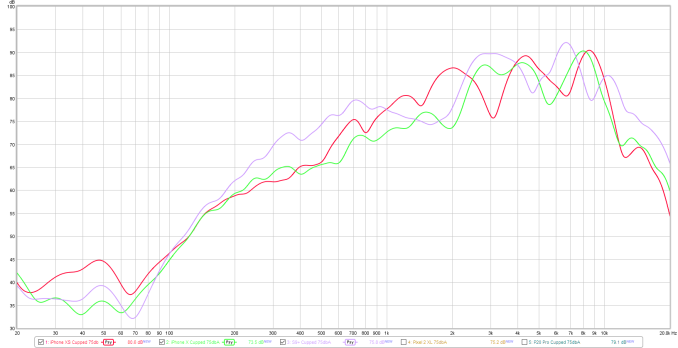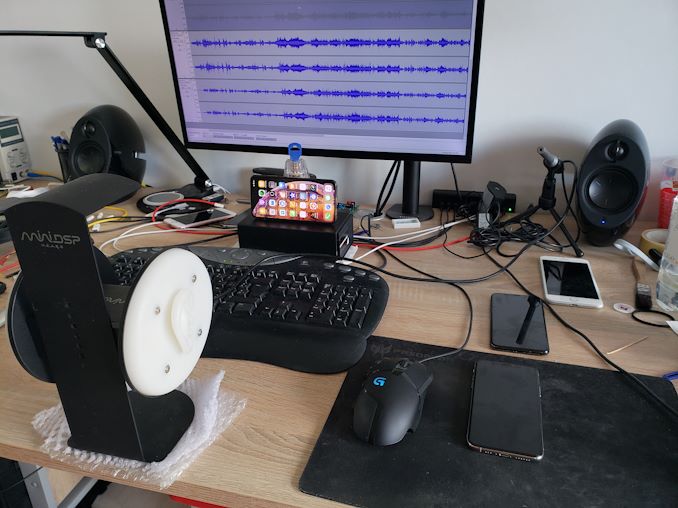The iPhone XS & XS Max Review: Unveiling the Silicon Secrets
by Andrei Frumusanu on October 5, 2018 8:00 AM EST- Posted in
- Mobile
- Apple
- Smartphones
- iPhone XS
- iPhone XS Max
Camera Video Recording
In terms of video recording, the iPhone XS promises an improved dynamic range in modes up to 30fps. What this likely means is that the phone’s able to capture in HDR mode in the 30fps modes, doing the same kind of processing we also see in SmartHDR still pictures.
Also something I’ve dreaded on iPhones for years; the new iPhone XS finally introduces stereo audio recording. Why it took Apple such a long time to finally introduce stereo recording is something that boggles the mind, but, let’s not complain, as we now finally have it on the new generation.
iPhone XS: iPhone X:
Comparing the iPhone XS video to the iPhone X, there’s one thing that is immediately very evident: the new XS is able to produce much better image stabilisation than last year’s flagship. Indeed, it looks like Apple vastly improved the OIS/EIS on the new phones, as the wobble that happens when walking is gone on the XS.
Audio recording finally is up to par, and we can hear the wind and rustling leaves of the trees around us. I think Apple might still have to work a bit on the wind noise cancellation, as in some parts the audio sounded as if it was inside a tube.
In terms of image quality, Apple’s claims of the improved dynamic range are very much verified. The phone showcases a lot more brought down highlights in the scene, and in darker areas, show better shadows. It’s unfortunate that this is limited only to the 30fps modes, but it’s understandable.
Switching over from the main lens to the telephoto lens happens relatively fast, although with a short exposure flash and a slight delay on the first zoom. 4K60 recording doesn’t allow for the use of the telephoto lens.
All in all, the video recording quality of the new iPhone XS is massively improved in all areas of stabilisation, picture quality, and audio. 4K30 recording on the XS is probably the best I’ve seen on any smartphone – a definitive applause to Apple for the improvements here.
Speaker Evaluation
Apple claimed to have improved the speaker audio quality on the new iPhone XS, allowing for more stereo separation and filling sound. I had introduced a new speaker evaluation method a few months ago because this year’s efforts by smartphone vendors to improve speaker quality has been very pronounced, and I wanted to have a way to objectively convey these improvements.
Starting off with speaker loudness, we’re measuring the phones at maximum volume, both in one-hand portrait mode, as well as two-handed mode where the palms are cupped towards the user. These two use-cases are what I find myself most often using the phone’s speakers in, so hopefully that also represents how most users use it as well, please let me know otherwise!

Using a pink noise signal, the iPhone XS pretty much falls into line with the results of the iPhone X, coming in at a very loud 82.8dBA in portrait mode and 87.6dbA in two-handed mode. Apple’s sound directionality on the iPhone X and XS is among the best, most likely due to the fact that the stereo earpiece is among the loudest of current generation smartphones.
Measuring the frequency response of the speakers, we see the iPhone XS closely following the measurement of the iPhone X, however there’s a major difference in the mid-range where the XS is around 5dB louder, raising instrumental frequencies and voices. This difference is what I think Apple is referring to when talking about better “fullness”, as it is evident when playing back media.
To better demonstrate the difference between the phones, I’ve attempted to capture them with a binaural microphone setup. Now I know my environment isn’t perfect as I don’t have the necessary sound dampening equipment, but I hope it does serve as an overall adequate A/B comparison between the phones. I’ve tried to calibrate the sound as much as possible recorded by the setup to a flat frequency response, although I’m sure there are improvements to be made. As a comparison, I also included calibrated speakers as a baseline to get an idea of the microphone setup.
The audio is meant to be listened to with headphones, or even better with IEMs, as this will give the intended playback of the binaural recording.
The iPhone XS’ improvements in the mid-range are quite evident as voices sound deeper and more pronounced on the new phone. Stereo separation is also quite good – resulting in a filling audio experience.
I included the S9+ and G7 as comparison devices. Samsung still does a significantly better job at the low-mid ranges which gives the phone more overall presence than the iPhones, also has an advantage in the very high frequencies giving more clarity, however the new iPhone’s XS strength point in the mid-ranges is the S9’s weakness, and vocals sound a lot less present than on the XS.
As for the G7, I just wanted to showcase a mono speaker device, and just how huge the audio difference is. Unfortunately the G7, even though it promises to have a good speaker, fails in practice.












253 Comments
View All Comments
alysdexia - Friday, May 10, 2019 - link
ODEDsHenk Poley - Saturday, October 6, 2018 - link
The OLEDs have a +41% higher pixel density as the LCD iPhones. So that's one reason why it could use more power.Constructor - Sunday, October 7, 2018 - link
OLEDs are simply much, much less efficient than the crystalline LEDs used as LCD backlights. They only have an advantage when the image is mostly black, which just isn't the case almost anywhere on the web or elsewhere.And the OLED displays in the X/XS are PenTile, so red and blue only have half the nominal resolution. The indicated resolution actually applies to green only. But the GPU will probably need to work harder for the PenTile compensation algorithm.
It still looks smudged to me especially at character edges (they're lined with tiny brownish/blueish pustules due to PenTile), and scrolling looks horribly janky, as if it was an old-time interlaced display, which is apparently due to the necessary PWM re-scanning.
Neither of these püroblems exist with the excellent LCDs Apple has been using since the iPhone 6, which still have proper full-resolution RGB pixels and due to the LCD inertia scroll buttery smooth.
So if any of the devices, it'll be the XR for me or none.
caribbeanblue - Thursday, September 24, 2020 - link
I thought the the buttery smooth looking scrolling on LCD was due to the more ghosting happening on the screen, no? When you’re scrolling text and images look clearer on OLEDS thanks to the lower amount of ghosting, but on LCDs pixels take more time to switch colors and that creates that smooth scrolling effect on the screen.Mic_whos_right - Tuesday, October 9, 2018 - link
That makes sense. still. isn't the OLED designs suppose to use zero batt at times during black? Maybe for movie borders?Constructor - Tuesday, October 9, 2018 - link
Yeah, I would also expect that the display controller should be able to go into low-power mode if it has all black pixels and it doesn't even need to scan in that state.Maybe there was some mistake in the measurement or the display wasn't actually completely black but just relatively dark with still some pixels on at lower brightness.
It could also be that the controller needs some startup time so it might not be able to shut down unless it can really know for sure there won't suddenly be some bright pixels again.
alysdexia - Friday, May 10, 2019 - link
aren't, supposedwrkingclass_hero - Friday, October 5, 2018 - link
I don't mind the minor typos, but I would have liked to have seen rec.2020 color gamut testing and sustained gameplay battery life.melgross - Saturday, October 6, 2018 - link
Nobody has a rec2020 monitor, so there’s no point in testing for it.jameskatt - Saturday, October 6, 2018 - link
Fantastic Review! But you missed the biggest item: The 8-Core Neural Processing Cores. These are used by Apple for Magic and huge acceleration of several tasks including realtime photo processing, Face ID, etc. These can be used in apps. The A12 has 18 cores - 2 Large CPU, 4 Small CPU, 4 GPU, and 8 NPU Cores.